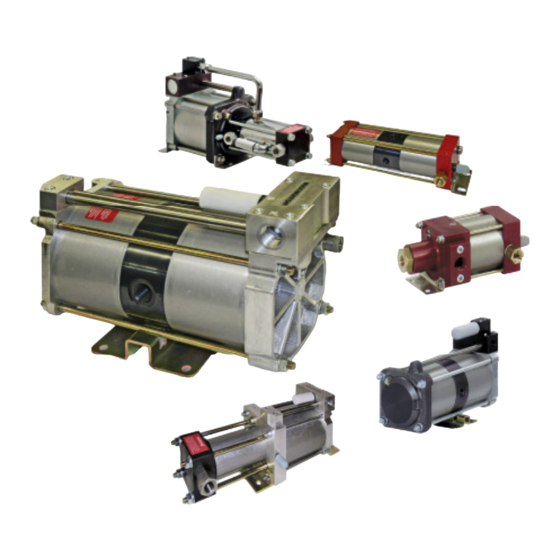
Table of Contents
Advertisement
Advertisement
Table of Contents

Summarization of Contents
1 Basic Information
1.1 Notes on the Assembly Instructions
Describes how to set up, operate, and maintain air amplifiers, emphasizing careful reading and adherence to instructions for safety and functionality.
1.2 Intended Use
Air amplifiers are used exclusively for compressing pre-amplified air to a desired final pressure, with a drive pressure limit of 10 bars.
1.3 Warranty and Liability
Outlines warranty conditions and liability exclusions, typically related to misuse, incorrect operation, or unauthorized modifications.
2 Safety Instructions
2.1 General Safety Directives
Applies EC Directives and harmonized standards. Emphasizes instruction of personnel and adherence to safety regulations for accident-free operation.
2.2 Symbols and Signal Terms
Explains hazard symbols (HAZARD, CAUTION) and signal terms (NOTE) used in the instructions for clear communication of risks and information.
2.3 Basic Safety Measures
Covers fundamental safety practices: technical condition, operation, maintenance, repair, and staff requirements. Includes notes on technical condition.
2.3.2 Safety instructions for operation
Details pre-operation checks, familiarization with equipment, maintaining suitable operating conditions, and immediate shutdown upon observing changes.
2.3.3 Safety instructions for maintenance and repair work
Stresses the importance of qualified personnel, cleanliness, and performing work only on depressurized equipment to prevent malfunctions and damage.
2.3.4 Requirements on staff
Mandates instruction on hazards, understanding of assembly instructions, use of protective clothing, and knowledge of operating procedures and emergency measures.
2.4 Special Safety Instructions
Addresses specific safety concerns: emissions (2.4.1), defective devices (2.4.2), and installation location (2.4.3).
3 Technical Description
3.1 Operation of Air Amplifiers
Explains that MAXIMATOR air amplifiers are compressed air-driven, increasing pressure by a specific ratio, and lists available models like GPLV, SPLV, MPLV.
3.1.1 MPLV 4 and MPLV 4L air amplifiers
Details the working principle of MPLV 4 and MPLV 4L air amplifiers, explaining the role of charge pressure, drive air, and pilot valves in pressure amplification.
3.1.2 MPLV 2, SPLV 2 and GPLV 2 air amplifiers
Describes the operation of MPLV 2, SPLV 2, and GPLV 2 air amplifiers, focusing on the flow of charge air and drive pressure to achieve pressure amplification.
3.2 Overview of Air Amplifiers
Presents a comparative overview of different air amplifier models (GPLV 2, SPLV 2, MPLV 2) with their figures and brief characteristics.
4 Assembly and Putting into Service
4.1 General Assembly Instructions on site
Covers general installation guidelines, including mounting position, foreign matter prevention, and torque specifications for assembling air amplifiers.
4.2 Compressed Air System
Details the requirement for a MAXIMATOR compressed air control unit downstream, comprising filter, separator, shut-off valve, controller, and manometer.
4.2.1 Compressed air lubricator
Discusses the use of a compressed air lubricator, its necessity for extremely dry air, and the caution against operating without it after initial use.
4.2.2 Pipe cross-sections
Advises on pipe specifications, ensuring they match or exceed the port thread size to prevent performance losses and malfunctions.
4.3 High-Pressure System
Emphasizes matching HP pipes and accessories to the air amplifier's pressure and cross-section to maintain performance and safety.
4.4 Putting into Service
Explains how to reduce pressure pulsations using bypass pipes or pressure tanks and the conditions under which air amplifiers start increasing pressure.
Connection options for air amplifiers
Details various connection options for air amplifiers, including control of operating pressure via drive pressure reduction or pressure switches.
5 Servicing and Maintenance
5.1 Maintenance Information
States that air drives are pre-treated with grease and require no other lubrication, but service parts need acid- and silicone-free grease.
5.2 Maintenance
Provides notes on using original spare parts and maintaining cleanliness during repair work for optimal performance and durability.
5.3 Repair
Gives instructions for repairing air amplifiers, emphasizing qualified personnel, absolute cleanliness, and potential damage from impurities.
5.3.1 Warranty
Covers the 12-month warranty on material quality and workmanship, excluding defects from incorrect handling, impermissible liquids, or exceeding pressure limits.
6 Technical Data
Pressure ratio
Details the pressure ratio specifications for various air amplifier models (GPLV, SPLV, MPLV) indicating the amplification factor.
Air drive pressure
Specifies the range of air drive pressure in bar for different air amplifier models, crucial for their operation.
Max. operating pressure
Lists the maximum permissible operating pressure in bar for each air amplifier model to ensure safe and effective use.
Max. noise level
Indicates the maximum noise level in decibels (dB) for all air amplifier models, important for workplace safety and comfort.
Max. operating temperature
Specifies the maximum operating temperature in degrees Celsius (°C) for all air amplifier models, defining operational limits.
Port for air drive pressure
Lists the specific port sizes (e.g., G 3/4", G 1/2", G 3/8") for air drive pressure connection on different models.
Port for pressure inlet
Details the port sizes for pressure inlet connection on various air amplifier models, ensuring proper air supply.
Port for pressure outlet
Specifies the port sizes for pressure outlet connection on different air amplifier models, facilitating output air flow.
Weight
Provides the weight in kilograms for each air amplifier model, useful for installation planning and handling.





Need help?
Do you have a question about the GPLV 5 and is the answer not in the manual?
Questions and answers